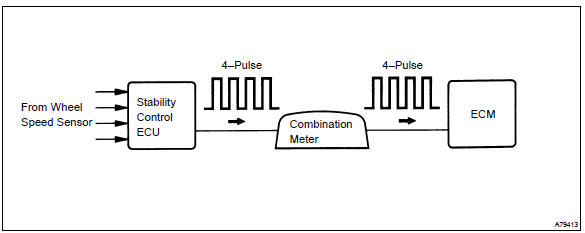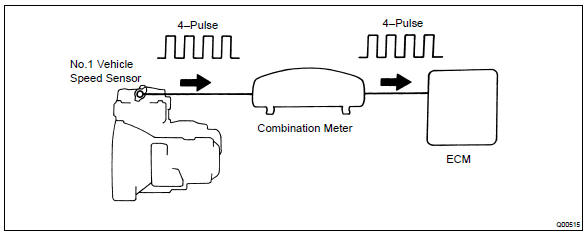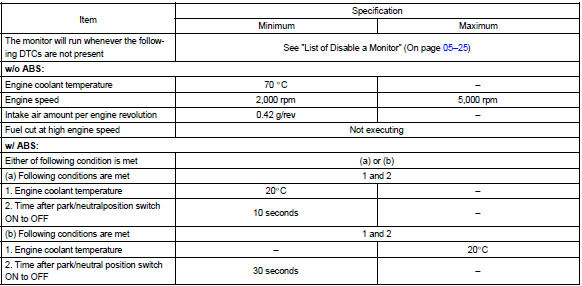Toyota Corolla (E120) 2002–2008 Repair Manual / Diagnostics / Sfi system / Vehicle speed sensor ”a” / Circuit description
Toyota Corolla (E120): Circuit description
The vehicle equipped with abs detects a vehicle speed using the stability control ecu and wheel speed sensor. This sensor monitors a wheel rotation speed and sends the signal to the ecu.
The stability control ecu converts these wheel speed signals into a 4–pulse signal and outputs it to the ecm via the combination meter.
The ecm determines the vehicle speed based on the frequency of these pulse signals.
In the vehicle without abs, the no. 1 Vehicle speed sensor outputs a 4–pulse signal for every revolution of the rotor shaft, which is rotated by the transmission output shaft via the driven gear. After this signal is converted into a more precise rectangular waveform by the waveform shaping circuit inside the combination meter, it is then transmitted to the ecm. The ecm determines the vehicle speed based on the frequency of these pulse signal.
W/ abs:

W/o abs:


Monitor description
Equipped with abs:
the ecm assumes that the vehicle is driven when the rpm of the transmission counter gear indicates more than 300 rpm and it has been over 30 seconds since the park/neutral position switch was turned off. If there is no signal from the vehicle speed sensor with these conditions satisfied, the ecm concludes that there is a fault in the vehicle speed sensor. The ecm will turn on the mil and a dtc is set.
Not equipped with abs:
the ecm assumes that the vehicle is driven when the park/neutral position switch is off and it has been over 4 seconds since the actual vehicle speed was 9 km/h or more.
If there is no signal from the vehicle speed sensor with these conditions satisfied, the ecm concludes that there is a fault in the vehicle speed sensor. The ecm will turn on the mil and a dtc is set.
Monitor strategy

Typical enabling conditions


Typical malfunction thresholds

Wiring diagram

Other materials:
Transmission wire (atm)
Replacement
1. Remove transmission valve body assy
2. Remove transmission wire
Disconnect the transmission wire connector.
removal the bolt and transmission wire.
3. Install transmission wire
Coat a o–ring with atf.
install the transmission wire and bolt.
To ...
Circuit description
The vapor pressure sensor and the vsv for the canister closed valve (ccv) are
used to detect abnormalities
in the evaporative emission control system. The ecm decides whether there is an
abnormality in the evaporative
emission control system based on the vapor pressure sensor signal.
Dtc p0 ...
Luggage compartment door
Adjustment
1. Inspect luggage compartment door panel sub–assy
check that the clearance is within the standard value.
2. Adjust luggage compartment door panel sub–assy
For forward/rearward and right/left adjustments, loosen
the bolts.
Torque: 7.0 N·m (71 kgf·cm, 62 i ...


